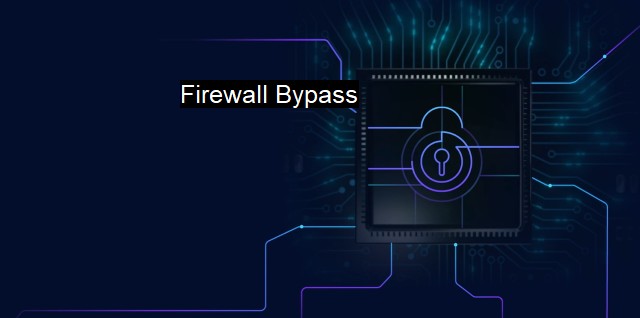What are Firewall Bypass?
Understanding Firewall Bypass Techniques in Cybersecurity: Threats and Mitigation Strategies
Firewall bypass is a term commonly used within the realm of cybersecurity and antivirus. As technology evolves, with a key emphasis on internet connection and the sharing of information, so does the potential for cyber-attacks, which can have destructive implications, often involving loss of data, unauthorized access, and disruption of systems. The function of firewalls and antivirus programs is to mitigate these potential security threats by providing a protective barrier or shield for your system against malicious activity.The concept of “firewall bypass” specifically refers to any methods, techniques, or processes used to circumvent, avoid, or bypass these firewalls in place, potentially instigating harm to the system. Understanding this context is critical for recognizing how necessary it is to keep your network, whether personal or business-orientated, adequately protected.
Firewalls are essentially barriers that exist between your system, like a personal computer, and another system or network, such as the internet. They scrutinize incoming and outgoing traffic between these systems based on predetermined rules and either allow or block them. Their main purpose is to prevent any unauthorized and potentially malicious activity from reaching the system that it protects.
Through firewall bypass, these preventive measures become futile as the protection firewalls offer is bypassed, enabling potential threats to infiltrate the system or network. This is typically done through system vulnerabilities, firewall configuration errors, or the exploitation of specific software applications that have been allowed by the firewall.
In terms of system vulnerabilities, these weaknesses or flaws in software systems can be maneuvered around, taking advantage of programming errors, insufficient security controls, or outdated applications. Utilizing these vulnerabilities, malicious actors may craft ways to bypass the stringent checks of the firewall, often penetrating networks without detection.
Firewall configuration errors, on the other hand, are instrumental to the performance of a system's firewall. Incorrect settings can lead to a failure of the firewall to prevent threats, rendering the system vulnerable. Misconfiguration could unintentionally allow potential harmful traffic to terminate at the firewall and eventually infiltrate the system.
Another common technique relies on exploiting specific software applications that are permitted by the firewall to interact across networks. This typically involves manipulating or mimicking the traffic patterns of these trusted applications in order to deceive the firewall, allowing unauthorized and potentially harmful data to pass through.
Regardless of these bypass methods, developers of cybersecurity products, including firewalls and antiviruses, constantly monitor any potential exploits. Regular updates and patches are introduced in response to these threats in a bid to overcome the bypass methods. Importantly, cybersecurity is a continuous and evolving process; it requires frequent updating and constant monitoring to stay a step ahead of malicious actors.
This demonstrates the alarming need for robust systems that can spot and block firewall bypass attempts and why the matter has been attracting significant attention from the cybersecurity community. Strategies to prevent firewall bypass typically include proper configuration, installing regular software updates and patches, network segmentation, and advanced threat detection technologies.
"firewall bypass" is a significant issue in the realm of cybersecurity and antivirus. By penetrating the protective barrier of firewalls, threat perpetrators can manipulate systems and data damagingly. As the digital world evolves, organizations and individuals must prioritize the consistent improvement of their cyber defense, deploying up-to-date firewalls and antivirus systems to reduce the risk of intrusion and unauthorized access, ultimately ensuring safety. Similarly, raising awareness about this issue and providing adequate education can also help in promoting a more secure digital environment.

Firewall Bypass FAQs
What is Firewall Bypass?
Firewall Bypass is a technique used by cybercriminals to circumvent security protocols set up by a firewall in order to get unauthorized access to a device or a network. It is often done to evade antivirus software and other security measures that are in place to protect the device or network from cyberattacks.How do cybercriminals bypass firewalls?
There are various ways in which cybercriminals can bypass firewalls, including using proxy servers to hide their IP addresses, exploiting vulnerabilities in the firewall, using backdoors to gain access to the network, or using social engineering techniques to trick employees into giving them access.What are the risks of Firewall Bypass?
Firewall Bypass can result in serious cybersecurity threats, including data breaches, ransomware attacks, and other forms of cybercrime. It can also compromise the security of a network, making it vulnerable to further attacks.How can you protect yourself from Firewall Bypass?
To protect yourself from Firewall Bypass, it is important to use strong and up-to-date antivirus software, keep your firewall updated, and train employees to recognize and avoid social engineering tactics. You can also implement multi-factor authentication and encryption protocols to protect against unauthorized access.| | A | | | B | | | C | | | D | | | E | | | F | | | G | | | H | | | I | | | J | | | K | | | L | | | M | |
| | N | | | O | | | P | | | Q | | | R | | | S | | | T | | | U | | | V | | | W | | | X | | | Y | | | Z | |
| | 1 | | | 2 | | | 3 | | | 4 | | | 7 | | | 8 | | |||||||